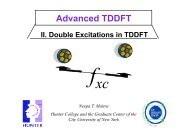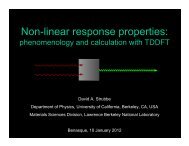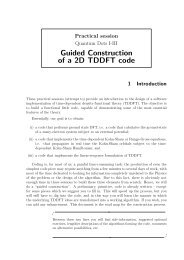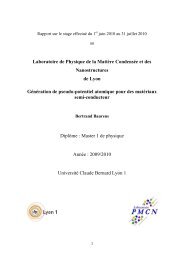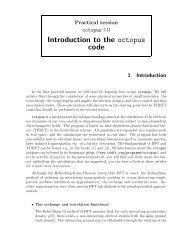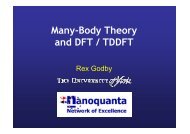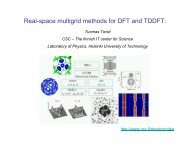Lucia Reining - TDDFT.org
Lucia Reining - TDDFT.org
Lucia Reining - TDDFT.org
You also want an ePaper? Increase the reach of your titles
YUMPU automatically turns print PDFs into web optimized ePapers that Google loves.
How to describe…………………1) Linear response in <strong>TDDFT</strong>a) <strong>TDDFT</strong> and spectroscopyb) <strong>TDDFT</strong> in practice2) Linear response in MBPTa) From Kohn-Sham to Quasi-Particlesb) Hedin’s equations and the BSEc) BSE in practice3) Comparisons…..4) …..and Combinations5) Outlook
<strong>TDDFT</strong> and spectroscopyV ext (r,t) ρ(r,t)responseLinear response: ρ ind = χ V extContent of χ ?
What is a spectrum?
hνWhat is a spectrum?
hνWhat is a spectrum?
hνWhat is a spectrum?
hνWhat is a spectrum?
Independent electrons and transitionshνcvIm [χ 0 ] ~ Σ vc || 2 δ (E c -E v -ω)
…but also:Perturbation -- ResponseResponse => Spectrum
Perturbation -- ResponseResponse => SpectrumPerturbation = external macroscopic
Perturbation -- ResponseResponse => SpectrumPerturbation = external macroscopic
Perturbation -- ResponseResponse => SpectrumPerturbation = external macroscopic
Perturbation -- ResponseResponse => SpectrumPerturbation = external macroscopic + inducedinduced = macroscopic
Perturbation -- ResponseResponse => SpectrumPerturbation = external macroscopic + inducedinduced = macroscopic + microscopic
V ind = (δV H /δρ + δV xc /δρ) δρPerturbation -- ResponseResponse => SpectrumPerturbation = external macroscopic + inducedinduced = macroscopic + microscopic
V ind = (δV H /δρ + δV xc /δρ) δρSelf-consistentPerturbation -- ResponseResponse => SpectrumPerturbation = external macroscopic + inducedinduced = macroscopic + microscopic
ρ ind = χ V extχ = χ 0 + χ 0 (v+f xc ) χ
ρ ind = χ V extχ = χ 0 + χ 0 (v+f xc ) χ v=δV H /δρ f xc =δV xc /δρVariation of “internal” potentialsEELS - response to V ext : -Im(χ)Absorption - response to V ext +V Hmacro: Im(χ)χ = χ 0 + χ 0 (v+f xc ) χ ρ ind = χ (V ext +V H macro )v = v – v(G=0)
1b) <strong>TDDFT</strong> in practicei) Finite system: 1 electron V xc = -V H(T+ V ext + V H –V H ) ϕ = ε ϕf xc = -vχ = χ 0χ = χ 0 + χ 0 (v+f xc ) χ“χ 0 is fine….” (for χand χ)more electrons: screening of f xcv becomes dominant“RPA is fine….” (for χand χ)“TDLDA is fine….” (for χand χ)
) Infinite system: long range important!RPA: α=1RPAABS: χ = χ 0 + χ 0 (v- v 0 ) χEELS: χ = χ 0 + χ 0 (v) χGeneral: v-αv 0Sottile et al (2002)EELS: α=0
EELS : v is dominantOlevano and <strong>Reining</strong> 2000
EELS : v is dominant“RPA is fine…”“TDLDA is fine…”Olevano and <strong>Reining</strong> 2000
Absorption: no long range in RPA.Any long range in f xc is therefore dramatic…..
How to get f xc ?hνcvWhat are these?Which interactions ?It is difficult to think in the Kohn-Sham world
So which potential in the “real world”?cv
So which potential ?cv
So which potential ?cv
So which potential ?cvHole - (N-1) electrons
Koopman’s theorem(e.g. Hartee Fock)(-∇ 2 /2 + V ext + V H + V xc ) |n> = E n |n>(-∇ 2 /2 + V ext + V H + Σ x |n> = E n |n>V xc (r) versus Σ x (r,r’)
ExchangeRelaxation - dynamical correlations(-∇ 2 /2 + V ext + V H + Σ x ) |n> = E n |n>(-∇ 2 /2 + V ext + V H + Σ(E n ) ) |n> = E n |n>Σ x (r,r’) versus Σ(r,r’,E n )
Hartree :Hartree - Fock :Beyond :ρ(r)ρ(r,r’)ρ(r,r’,t,t’)
One-particle Green’s function:G(x,x’,t,t’) = -iIf |N> = 1 Slater determinant:for t
From ∂ρ/∂tto:∂/∂t G =……….……leads to G (2) (4 field operators)Introduce potential Σ..... (G -1 = G H-1– Σ)…….to be defined implicitlyPerturbation δV ext Σ = - iGv(δG -1 /δV ext )
From ∂ρ/∂tto:∂/∂t G =……….……leads to G (2) (4 field operators)Introduce potential Σ..... (G -1 = G H-1– Σ)…….to be defined implicitlyPerturbation δV ext Σ = - iGv(δG -1 /δV ext )
Σ = i ∫GWΓW = v + ∫v P WP = - i ∫GGΓΓ = δ + ∫ δΣ/δG GGΓ(G -1 = G H-1– Σ)Hedin’s equations
Σ = i ∫GWΓW = v + ∫v P WP = - i ∫GGΓΓ = δ + ∫ δΣ/δG GGΓ(G -1 = G H-1– Σ)Γ = δ
Σ = i ∫GWΓW = v + ∫v P WP = - i ∫GGΓΓ = δ + ∫ δΣ/δG GGΓ(G -1 = G H-1– Σ)Γ = δ
Σ = i ∫GWΓ = i GWW = v + ∫v P WP = - i ∫GGΓ = -iGGΓ = δ + ∫ δΣ/δG GGΓ(G -1 = G H-1– Σ)Γ = δGW Approximation, Hedin 1965
E c -E v (minimum, eV)DFT-KSΣ=iGWExp.SiliconDiamondMgO0.554.265.31.195.647.81.175.487.83(HF much bigger! Even Silicon……)….this makes the solid so difficult!!!
W = v + ∫v P W(1 -vP) W = vW=(1 -vP) -1 v = ε -1 v = (1+vχ)v“χ” = P + P v χP = - i ∫GGΓ
Γ = δΣ = i ∫GWΓW = v + ∫v P WP = - i ∫GGΓRPA formΓ = δ + ∫ δΣ/δG GGΓ
Γ = δΣ = i ∫GWΓW = v + ∫v P WP = - i ∫GGΓΓ = δ + ∫ δΣ/δG GGΓ-i ∫GGΓ = -i GG -i ∫GG ∫ δΣ/δG GGΓP = P 0 + P 0 δΣ/δG iP Bethe SalpeterΣ = i GWP ≅ P 0 -P 0 W P χ = P 0 + P 0 (v-W) χ
χ = P 0 + P 0 (v-W) χδV H /δρ
χ = P 0 + P 0 (v-W) χδV H /δρδΣ/δG
χ = P 0 + P 0 (v-W) χδV H /δρ δΣ/δG δΣ(12)/δG(34)
Absorption ?cv
Absorption ?cv
Absorption ?cvElectron-hole interactionExcitonic effectsBethe-Salpeter Equation
Absorption ?cVariation of potentialvElectron-hole interactionExcitonic effectsBethe-Salpeter Equation
χ=χ 0 + χ 0 (v-W) χ =
(H el + H hole + H el-hole ) A λ = E λ A λVariation of potentialIm [ε] ~ Σ vc || 2δ (E c -E v -ω)Im [ε] ~ Σ λ | Σ vc A λvc| 2 δ (E λ -ω)->Mixing of transitions->Modification of excitation energies
RPABSE
BSE and <strong>TDDFT</strong>: different worlds, same physics<strong>TDDFT</strong>:χ = χ 0 + χ 0 (v+f xc ) χBSE:(H el + H hole + H el-hole ) A λ = E λ A λ
BSE and <strong>TDDFT</strong>: different worlds, same physics<strong>TDDFT</strong>:χ = χ 0 + χ 0 (v+f xc ) χδV H /δρδV xc /δρBSE:(H el + H hole + H el-hole ) A λ = E λ A λ
BSE and <strong>TDDFT</strong>: different worlds, same physics<strong>TDDFT</strong>:χ = χ 0 + χ 0 (v+f xc ) χδV H /δρδV xc /δρBSE:(H el + H hole + H el-hole ) A λ = E λ A λ(∆E GW + - ) A λ = E λ A λ
BSE and <strong>TDDFT</strong>: different worlds, same physics<strong>TDDFT</strong>:χ = χ 0 + χ 0 (v+f xc ) χδV H /δρδV xc /δρBSE:(H el + H hole + H el-hole ) A λ = E λ A λ(∆E GW + - ) A λ = E λ A λδV H /δρδΣ xc /δG
BSE and <strong>TDDFT</strong>: different worlds, same physics<strong>TDDFT</strong>:χ = χ 0 + χ 0 (v+f xc ) χδV H /δρδV xc /δρBSE:4 χ = 4 χ 0 + 4 χ 0 (v+δΣ xc/ δG) 4 χ(∆E GW + - ) A λ = E λ A λδV H /δρδΣ xc /δG
BSE and <strong>TDDFT</strong>: different worlds, same physics<strong>TDDFT</strong>:χ = χ 0 + χ 0 (v+f xc ) χ(∆E KS + - ) A λ = E λ A λBSE:4 χ = 4 χ 0 + 4 χ 0 (v+ δΣ xc/ δG ) 4 χ(∆E GW + - ) A λ = E λ A λ
BSE and <strong>TDDFT</strong>: different worlds, same physics…….but <strong>TDDFT</strong> direct + fast!!!<strong>TDDFT</strong>:χ = χ 0 + χ 0 (v+f xc ) χ(∆E KS + - ) A λ = E λ A λBSE:4 χ = 4 χ 0 + 4 χ 0 (v+ δΣ xc/ δG ) 4 χ(∆E GW + - ) A λ = E λ A λ
BSE and <strong>TDDFT</strong>: different worlds, same physics…….but <strong>TDDFT</strong> direct + fast!!!<strong>TDDFT</strong>:χ = χ 0 + χ 0 (v+f xc ) χ(∆E KS + - ) A λ = E λ A λf xc = 0 : RPAf xc = δV xcLDA/δρ : TDLDA
TDLDA
Solids: TDLDA ~ RPACan we get f xc from BSE?
BSE and <strong>TDDFT</strong>: different worlds, same physics…….but <strong>TDDFT</strong> direct + fast!!!<strong>TDDFT</strong>:χ = χ 0 + χ 0 (v+f xc ) χ(∆E KS + - ) A λ = E λ A λBSE:(∆E GW + - ) A λ = E λ A λ4 χ = 4 χ 0 + 4 χ 0 (v+ δΣ xc/ δG ) 4 χ
Comparison in“Transition” spaceΦ(n1,n2;r)≡ψ (r)ψ* (r)n1 n2FBSE(n1n2)(n3n4)=−∫drdr'Φ(n1,n3;r)W(r',r)Φ * (n2,n4;r')F<strong>TDDFT</strong>(n1n2)(n3n4)= ∫ drdr'Φ(n1,n2;r)fxc(r,r')Φ * (n3,n4;r')
Comparison in“Transition” spaceΦ(n1,n2;r)≡ψ (r)ψ* (r)n1 n2FBSE(n1n2)(n3n4)=−∫drdr'v,v’c,c’Φ(n1,n3;r)W(r',r)Φ * (n2,n4;r')F<strong>TDDFT</strong>(n1n2)(n3n4)= ∫ drdr'Φ(n1,n2;r)fxc(r,r')Φ * (n3,n4;r')v,c v’,c’
Asymptotic long-range behaviorof the xc KernelΦ (v,k (v,k,c,k ,c,k +q +q ;G ;G =0) =0) q → q 0 0O (q (q))→constq→0F (n1n2)(n3n4) q→0(n1n2)(n3n4)( )ffxc ( ,G G' 0) q 02xc ( q ,G = G' = 0) → q 0 O 1 q 2
<strong>Reining</strong>, Olevano, Rubio, Onida (PRL 2002)
Botti et al (2002)Refraction Index
Botti, Vast, <strong>Reining</strong>, Olevano, Andreani (PRL, 2002)
Botti et al (2002)
•The lack of a long range term in f xcLDAisrelatively weightless in the EEL but iscrucial in Absorption spectra!Our Explanation⎧ EEL ∝ ε −1 =1+vχ⎨⎩ χ=χ (0) +χ (0) (v+ f xc )χ• In the EEL f xc is added to the full Coulombian that already contains along range contribution⎧ ε M =1−vχ⎨⎩ χ =χ (0) +χ (0) (v + f xc )χCoulombianwithout long range termAbsorption• In the Absorption spectra f xc is added to a Coulombian thatdoes not contain a long range contribution
BSE and <strong>TDDFT</strong>: merge!<strong>TDDFT</strong>:χ = χ 0 + χ 0 (v+f xc ) χ
BSE and <strong>TDDFT</strong>: merge!<strong>TDDFT</strong>:χ = χ 0 + χ 0 (v+f xc ) χχ = (1- χ 0 (v+f xc )) -1 χ 0
BSE and <strong>TDDFT</strong>: merge!<strong>TDDFT</strong>:χ = χ 0 + χ 0 (v+f xc ) χχ = (1- χ 0 (v+f xc )) -1 χ 0χ =X (X - χ 0 (v+f xc )X) -1 χ 0X =Σ vc |vc>
BSE and <strong>TDDFT</strong>: merge!<strong>TDDFT</strong>:χ = χ 0 + χ 0 (v+f xc ) χχ =X (X - χ 0 (v+f xc )X) -1 χ 0X =Σ vc |vc>
BSE and <strong>TDDFT</strong>: merge!<strong>TDDFT</strong>:χ = χ 0 + χ 0 (v+f xc ) χχ =X (X - χ 0 (v+f xc )X) -1 χ 0X =Σ vc |vc>
BSE and <strong>TDDFT</strong>:”Mapping theory”<strong>TDDFT</strong>:(∆E KS + - ) A λ = E λ A λBSE:(∆E GW + - ) A λ = E λ A λ
BSE and <strong>TDDFT</strong> :”Mapping theory”<strong>TDDFT</strong>:χ = χ 0 + χ 0 (v+f xc ) χχ =X (X - χ 0 (v+f xc )X) -1 χ 0χ =X (X - χ 0 v X + Τ) -1 χ 0χ 0 with GW energiesT= Σ vc,v’c’ 1/(E c -E v -ω) |vc> > >
Silicon: Optical AbsorptionF. Sottile et al.,Phys Rev. Lett91, 056402 (2003).Parameter-free!!!
Solid Argon: Bound Excitons• Francesco Sottile, PhD thesis (2003)
BSE and <strong>TDDFT</strong> :”Mapping theory”<strong>TDDFT</strong>:χ = χ 0 + χ 0 (v+f xc ) χχ =X (X - χ 0 (v+f xc )X) -1 χ 0χ =X (X - χ 0 v X + Τ) -1 χ 0χ 0 with GW energiesT= Σ vc,v’c’ 1/(E c -E v -ω) |vc> > >
Advantages over BSE: Diago,inversion SumAdvantages of this approach:- interpolation,……- change order of operations no 4point- modelisation (long range etc)<strong>Reining</strong> et al, PRL 88, 066404 (2002); Sottile et al, PRL 91, 056402 (2003)Perturbation theory:- work with χ 0 f xc , not f xc- flexible: χ 0 XAdragna PhD thesis and PRB 68, 165108 (2003),Marini et al PRL 91, 256402 (2003) :X χ 0 )
All of us:•Potentially efficient 2-point simulation of BSE results•Inspired by <strong>TDDFT</strong>•Is it <strong>TDDFT</strong>? (We have still QP energies)χ= χ 0QP+ χ 0QP(v+f xcmb) χχ= χ 0KS+ χ 0KS(v+f xc ) χ f xc = f xcmb+ (χ 0QP) -1 -(χ 0KS) -1
ConclusionWe can get DF quantities from MBPT (well known)The aim is to simplify our life:MBPT is more “understandable”DFT is more “efficient”.The difficulty: get the DF answer without solving the wholemany-body problem first!In the case of the BSE – <strong>TDDFT</strong> this has worked out fine.
How to describe exchange and correlation effectsin the response properties of valence electrons?Answers from <strong>TDDFT</strong> and MBPTSilvana BottiFabien BrunevalApostolos MarinopoulosValerio OlevanoFrancesco SottileNathalie Vast<strong>Lucia</strong> <strong>Reining</strong>Laboratoire des Solides IrradiésPalaiseauNANOPHASE-NANOQUANTA



